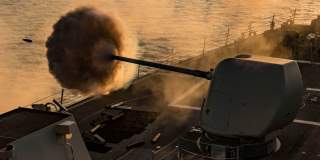The Navy Is Getting Railguns, And Not Even Mountains Will Stand In Their Way
The future of warfare is now.
Key point: Eventually, the Navy will have to test a full-up railgun.
While the U.S. Navy had announced last year that it would take a prototype railgun to sea onboard the expeditionary fast transport USNS Trenton (JHSV-5) in 2016, the service may have to scupper those plans.
If the Navy does take the railgun out to sea on a fast transport, it will be in 2017 at the earliest. In lieu of testing the prototype rail gun in an at-sea environment, the Navy might instead proceed directly to developing an operational weapon system.
“It’s not definitely off but it’s not definitely going ahead,” Rear Adm. Peter Fanta, the Navy’s director of surface warfare, told Defense News during a Dec. 30 interview.
“Primarily because it will slow the engineering work that I have to do to get that power transference that I need to get multiple repeatable shots that I can now install in a ship. And I would frankly rather have an operational unit faster than have to take the nine months to a year it will take to set up the demo and install the systems, take the one operational [railgun] unit I have, put it on a ship, take it to sea, do a dozen shots, turn around, take it off, reinstall it into a test bed.”
Fanta said that he believes that an operational railgun is feasible within the next five years. Indeed, the Navy hopes to replace one of the 155mm gun turrets onboard the third and final Zumwalt-class destroyer Lyndon B. Johnson (DDG 1002) with a rail gun. “I don’t know if I can get there from the engineering status yet. But that’s what we continue to look at,” Fanta told Defense News.
According to Fanta, most of the key technologies behind railguns—which have until now mostly been in the realm of science fiction—have been unlocked. “It’s engineering at this point, it’s no longer science,” Fanta told Defense News. “It’s no longer the deep dark secrets of what can I do with this sort of energy. It’s engineering and how much power density can I get, how much beam quality can I get, what sort of metallurgy do I need to sustain multiple shots over multiple periods of time. The rail gun as well as the laser.”
Solving the metallurgy problem might require novel solutions—and it’s possible a solution might not exist. “My old gun barrels used to last me a few thousand rounds. Is that still the way we want to go? Other countries are solving it the other way,” Fanta told Defense News.
“Maybe if I carry four barrels and have them easily swapped out with a bunch of bosun’s mates on the [forecastle] and stick [them] in and a half-turn and you go. It’s kind of the way we do it when we overheat machine guns. The new machine guns, you got the old barrel, you stick in a new one and you keep shooting. Maybe that’s the way to go if we can’t solve the metallurgy issues that allow me to do 1,000 rounds out of a barrel.”
Eventually, the Navy will have to test a full-up railgun. The trick will be to find a suitable range where the weapon can be fired at maximum range and velocity. But if the test program moves from Dahlgren, Virginia, to the White Sands Missile Range in New Mexico, it won’t be able to conduct the at-sea demo onboard a fast transport.
Recommended: Imagine a U.S. Air Force That Never Built the B-52 Bomber
Recommended: Russia's Next Big Military Sale - To Mexico?
Recommended: Would China Really Invade Taiwan?
“I need to be able to see how this thing—for both the projectile and the gun—how it shoots at full range, which means I need both elevation and altitude and long range where I can go blow the top off a mountain someplace and not worry about someone fishing around somewhere,” Fanta told Defense News. “The discussion now [is to] move it to a better site that allows me to do full range testing, or do I go do the demo? Because it’s an either/or, it’s not both at this point.”
This article first appeared several years ago.
Image: Creative Commons.

